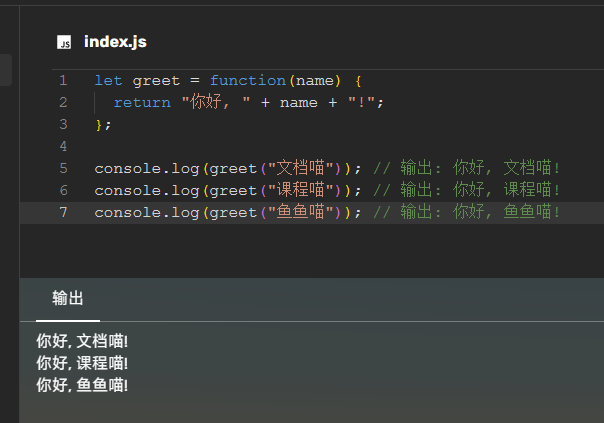在上一节中,我们学习了循环语句,可以只运行一次程序,就能同时输出多种不同的中奖结果的情况。
问题来了,我这里现在有3台抽奖机,每个抽奖机处理逻辑是一样的,但是中奖数值不一样,该怎么办呢?
欸,聪明的你一定想到了,我重复写三次代码,然后改变中奖概率不就好了吗? 嗯,确实如此。
点击聪明的你实现过程
javascript
let guessNum = 10; // 中奖数值
for (let i = 1; i <= 15; i++) {
let randomNum = Math.floor(Math.random() * 101);
if (guessNum >= randomNum) {
console.log('运气差点,生成的数字是' + randomNum);
} else {
let diff = randomNum - guessNum;
if (diff > 80) {
console.log('运气超级爆棚,你中奖啦!生成的数字是' + randomNum);
} else if (diff > 40) {
console.log('运气爆棚,你中奖啦!生成的数字是' + randomNum);
} else if (diff > 10) {
console.log('运气还行,你中奖啦!生成的数字是' + randomNum);
} else {
console.log('厉害!刚刚过线,你中奖啦!生成的数字是' + randomNum);
}
}
}
guessNum = 30; // 中奖数值
for (let i = 1; i <= 15; i++) {
let randomNum = Math.floor(Math.random() * 101);
if (guessNum >= randomNum) {
console.log('运气差点,生成的数字是' + randomNum);
} else {
let diff = randomNum - guessNum;
if (diff > 80) {
console.log('运气超级爆棚,你中奖啦!生成的数字是' + randomNum);
} else if (diff > 40) {
console.log('运气爆棚,你中奖啦!生成的数字是' + randomNum);
} else if (diff > 10) {
console.log('运气还行,你中奖啦!生成的数字是' + randomNum);
} else {
console.log('厉害!刚刚过线,你中奖啦!生成的数字是' + randomNum);
}
}
}
guessNum = 65; // 中奖数值
for (let i = 1; i <= 15; i++) {
let randomNum = Math.floor(Math.random() * 101);
if (guessNum >= randomNum) {
console.log('运气差点,生成的数字是' + randomNum);
} else {
let diff = randomNum - guessNum;
if (diff > 80) {
console.log('运气超级爆棚,你中奖啦!生成的数字是' + randomNum);
} else if (diff > 40) {
console.log('运气爆棚,你中奖啦!生成的数字是' + randomNum);
} else if (diff > 10) {
console.log('运气还行,你中奖啦!生成的数字是' + randomNum);
} else {
console.log('厉害!刚刚过线,你中奖啦!生成的数字是' + randomNum);
}
}
}1
2
3
4
5
6
7
8
9
10
11
12
13
14
15
16
17
18
19
20
21
22
23
24
25
26
27
28
29
30
31
32
33
34
35
36
37
38
39
40
41
42
43
44
45
46
47
48
49
50
51
52
53
54
55
56
57
58
59
60
2
3
4
5
6
7
8
9
10
11
12
13
14
15
16
17
18
19
20
21
22
23
24
25
26
27
28
29
30
31
32
33
34
35
36
37
38
39
40
41
42
43
44
45
46
47
48
49
50
51
52
53
54
55
56
57
58
59
60
哇塞,这代码好长!但是重复代码非常多,能不能减少重复代码呢?
这里就可以运用到函数啦!
认识函数
在JavaScript中,函数是一段可以重复使用的代码块,用于执行特定任务。函数可以接受输入(称为参数),并返回输出(称为返回值)。
数据类型
Object:js语言中更复杂的数据结构,如数组、函数、日期等都属于对象类型。
javascriptlet func = function functionName() {}1Undefined:当一个变量被声明了但没有被赋值时,它的值是
undefined。javascriptlet something; console.log(something); // 输出:undefined1
2
函数的基本语法
JavaScript函数使用function关键字声明,后跟函数名和圆括号(可能包含参数),以及花括号内的函数体。
javascript
function functionName(parameters) {
// 函数体
return result; // 可选返回值
}1
2
3
4
2
3
4
调用函数
一旦函数被定义,你就可以通过函数名和圆括号(可包含参数)来调用它。
javascript
function sayHello(name) {
return "你好, " + name + "!";
}
console.log(sayHello("吉吉喵")); // 输出: 你好, 吉吉喵!
console.log(sayHello("美术喵")); // 输出: 你好, 美术喵!
console.log(sayHello("搬砖喵")); // 输出: 你好, 搬砖喵!1
2
3
4
5
6
7
2
3
4
5
6
7

函数的参数
函数可以定义任意数量的参数,调用时也可以传递任意数量的实际参数。
JavaScript中的参数是可选的。
javascript
function sum(a, b) {
return a + b;
}
function sayHello() {
console.log("Hello!");
// 如果没有return语句,函数将返回 undefined。
}
console.log(sum(1, 2)); // 输出: 3
console.log(sum(1, 2, 3)); // 输出: 3,忽略多余的参数
sayHello() // 输出: Hello!
console.log(sayHello()); // 函数内部输出: Hello!,但这里输出 undefined1
2
3
4
5
6
7
8
9
10
11
12
13
14
2
3
4
5
6
7
8
9
10
11
12
13
14

匿名函数
没有名称的函数称为匿名函数。它们经常作为参数传递给其他函数(如回调函数)或直接赋值给变量。
javascript
let greet = function(name) {
return "你好, " + name + "!";
};
console.log(greet("文档喵")); // 输出: 你好, 文档喵!
console.log(greet("课程喵")); // 输出: 你好, 课程喵!
console.log(greet("鱼鱼喵")); // 输出: 你好, 鱼鱼喵!1
2
3
4
5
6
7
2
3
4
5
6
7

箭头函数
箭头函数提供了一种更简洁的函数书写方式,特别适用于非方法函数。
javascript
let sayHelloArrow = (name) => {
return `你好, ${name}!`;
};
//或更简洁写法
let sayHelloArrow2 = name => `你好, ${name}!`;
console.log(sayHelloArrow("吉吉喵")); // 输出: 你好, 吉吉喵!
console.log(sayHelloArrow2("美术喵")); // 输出: 你好, 美术喵!1
2
3
4
5
6
7
8
9
2
3
4
5
6
7
8
9
课后练习
小朋友,根据学到的函数知识,完成开头留下的问题吧!
抽奖程序:我这里现在有3台抽奖机,每个抽奖机处理逻辑是一样的,但是中奖数值不一样,该怎么办呢?
点击查看参考答案
javascript
// 定义一个抽奖函数,执行逻辑都一样的,只不过中奖数值不一样。
function prizeDraw(guessNum) {
for (let i = 1; i <= 15; i++) {
let randomNum = Math.floor(Math.random() * 101);
if (guessNum >= randomNum) {
console.log('运气差点,生成的数字是' + randomNum);
} else {
let diff = randomNum - guessNum;
if (diff > 80) {
console.log('运气超级爆棚,你中奖啦!生成的数字是' + randomNum);
} else if (diff > 40) {
console.log('运气爆棚,你中奖啦!生成的数字是' + randomNum);
} else if (diff > 10) {
console.log('运气还行,你中奖啦!生成的数字是' + randomNum);
} else {
console.log('厉害!刚刚过线,你中奖啦!生成的数字是' + randomNum);
}
}
}
}
prizeDraw(10) // 普通抽奖机 抽到的数大于10即中奖
prizeDraw(30) // 上等抽奖机 抽到的数大于30即中奖
prizeDraw(65) // 极品抽奖机 抽到的数大于65即中奖1
2
3
4
5
6
7
8
9
10
11
12
13
14
15
16
17
18
19
20
21
22
23
24
2
3
4
5
6
7
8
9
10
11
12
13
14
15
16
17
18
19
20
21
22
23
24
它实现的效果和开头给的那串长长的代码一样的哦! 代码是不是减少了很多?